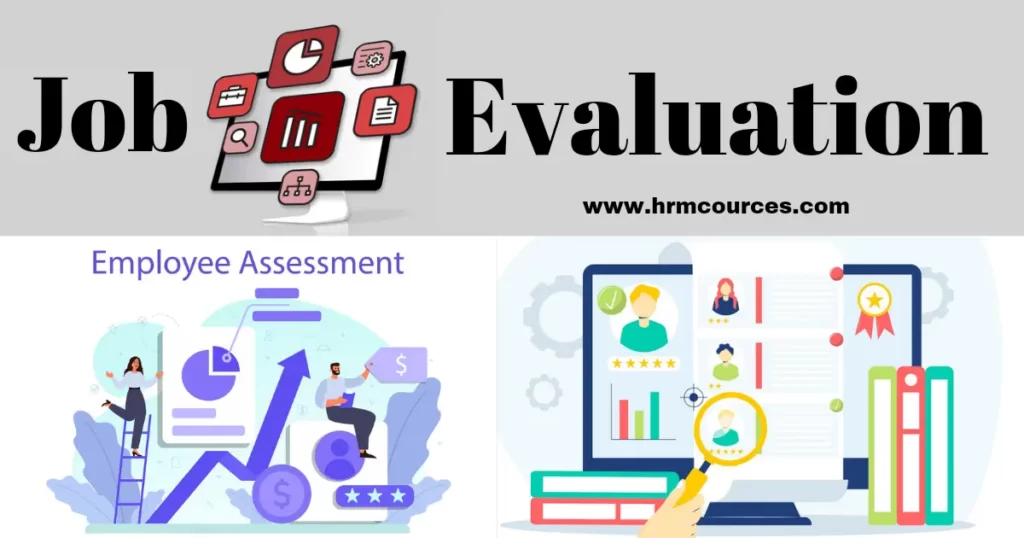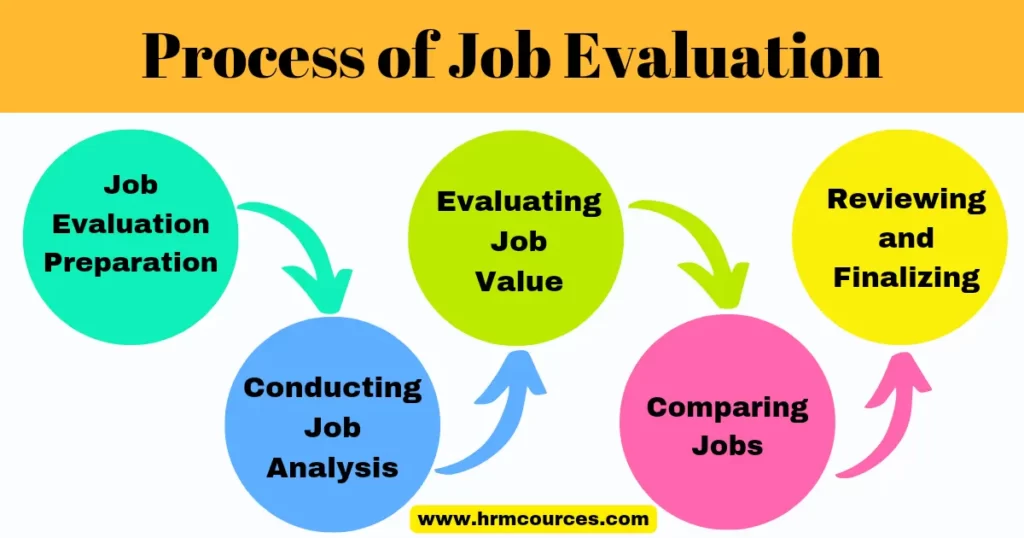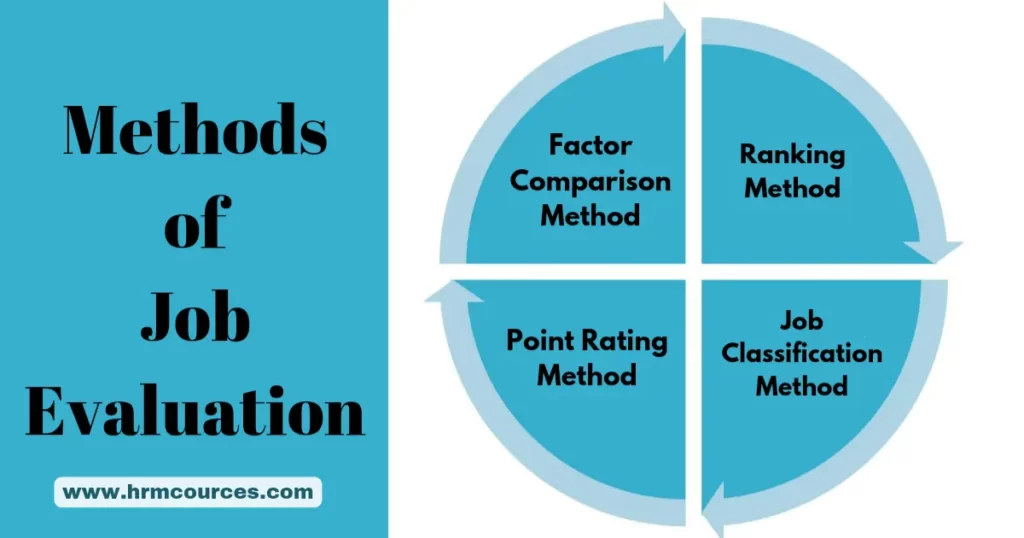Introduction
Job evaluation is a significant tool in human resource management since it offers a structured system for evaluating the worth and value of various positions in a firm.
When the importance of job evaluation is recognized, it will be easier for organizations to decide on pay strategy, promotions and training of employees.
Understanding Job Evaluation Meaning
Job Evaluation Definition and Concept
Definition:- Job evaluation can be described as the regular and systematic assessment of the value and importance of different jobs that are available in an organization.
It involves the evaluation of different parameters like skills and knowledge needed for the job, the work content and its complexity, decision-making power required for the job, and so on.
Concept:- Several principles are used to determine the proper and fair way to evaluate and appraise the jobs. These principles include:

- Equity: Its objective is to ensure that employees are paid in fair manner depending with the worth of the job they hold.
- Objectivity: The nature of the evaluation has to be fair, clean, unbiased and has to be done a bit independently.
- Consistency: It is necessary to have a regularity in using a set of criteria and procedures for assessment within an organization.
Table of Contents
Job Evaluation Objectives and Benefits
The main goals of the job analysis are to integrate internal equity, evaluate & rank jobs to compare their worth and link roles with the reward.
By implementing job evaluation, organizations can achieve the following benefits:
- Compensation Fairness: Job evaluation assists to reduce disparities in the payment structures since it ensures that the employees receive fair wages based on the job that they are performing.
- Recruitment and Retention: A sound job evaluation system aids an organization to offer right remuneration packages in the market hence making the organization attract and retain employee.
- Performance Management: Employees’ evaluation helps to relate reward with performance, so that people work with more dedication.
- Organizational Structure: Job evaluation enables the determination of clear job hierarchies, this aids in the right placement of organisation structures and decision making plans.
Process of Job Evaluation

Steps in job evaluation process:
Preparing for Job Evaluation
Before conducting a job evaluation process, several preparatory steps need to be taken:
- Identifying the Need for Job Evaluation: During the growth of an organization or when there are strategic changes that affect the various job positions, organizations must identify that at what time the job evaluation is necessary.
- Assembling the Evaluation Committee: Thus the company should form a diverse committee of HR professionals, managers and other subject matter experts for the purpose of objective assessment of job positions.
- Establishing Evaluation Criteria: Skills, responsibilities, and decision-making authorities being employment attributes for jobs to be used as basis for selection and comparison should be clearly defined.
Conducting Job Analysis
Job analysis is a crucial step in the job evaluation process and involves:
- Conducting Interviews and Surveys: HR professionals can conduct a structured or an unstructured survey of the organization in which the employees and the supervisors are asked to provide information about the different jobs within the organization.
- Analyzing Job Descriptions and Requirements: Hr professionals should analyze job description and the requirements of the job according to the job specification in the organization.
Evaluating Job Worth and Value
This stage focuses on determining the worth and value of jobs based on the following factors:
- Compensable Factors: These job worth attributes include education, experience, complexity, and accountability among others that are offered by the HR professionals in determining them.
- Assigning Point Values to Job Factors: The major advantage of these models is that the factors can be quantitatively evaluated using values assigned to each factor in accordance with its relevance to a specific job.
- Assessing Job Complexity: The level of tasks in every job is determined by other factors such as difficulty in problem solving, decision making and working independent.
Comparing Jobs
Once the evaluation process is complete, jobs can be compared and ranked:
- Ranking Jobs Based on Point Values: Promotions of the jobs are done based on the point scores awarded to them, which provides an organization with a structure of job significance in the company.
- Creating Job Evaluation Hierarchies: This is because there is a hierarchy of positions whereby one position is considered to be more important and worth more than the other.
- Identifying Job Relationships: Analysis of assessment results enables one to determine the relations and link between the job positions within the organization.
Reviewing and Finalizing Job Evaluation
Before finalizing the job assessment process, certain steps need to be taken:
- Conducting Quality Checks: This ensures that efficiency and quality in the results that are likely to be obtained from the actual job evaluation is achieved.
- Obtaining Feedback from Stakeholders: Employees, supervisors and others stakeholders feedback is important during the evaluation process because they are the one who complete the assessment of the job roles.
- Making Necessary Adjustments: Employment related improvements or changes can then be made on the assessment of the jobs based on the feedbacks and the control tests.
Communicating Results
After the evaluation process, it is important to effectively communicate the results to the employees:
- Sharing Job Assessment Outcomes with Employees: The evaluation results should be shared to the employees in order to understand the fairness behind the compensation decision.
- Addressing Concerns and Questions: Employers should offer options to the employees to freely forward any questions or complaints that they have concerning the job assessment procedure.
Tips or best practices for a successful process of job evaluation
Here are some tips and best practices to help organizations achieve success in their job evaluation efforts:
- Clearly Define Objectives:
- First of all, it is crucial to establish the goals and purposes of the job evaluation. First, identify your goal, be it providing fair pay, internal pay parity, or pay-for-performance benchmarked against the market standards.
- Involve Stakeholders:
- Ensure that you involve people from different departments and positions in your organization when conducting job evaluation. It also helps to bring in different viewpoints and thus secures the support of people.
- Use a Consistent Methodology:
- It is essential to select the type of job assessment that will work well for the organization and its organizational culture. Even when choosing between point factor, ranking, classification, or market pricing, be sure to be consistent with your choice.
- Thorough Job Analysis:
- Conduct comprehensive job analyses to collect accurate and up-to-date information about job roles, responsibilities, qualifications, and working conditions. This forms the foundation of your evaluation.
- Training and Education:
- Train your job assessment committee members and stakeholders on the chosen methodology. Ensure they understand the criteria and factors being evaluated.
- Transparency:
- Ensure that there is traceability of the process by being fully open. Inform the employees and the stakeholders about the aims, processes, and expected results. Respond to any of your questions or concern as soon as possible.
- Committee Composition:
- Choose an experienced committee that includes HR, potential users of the job descriptions, and knowledge workers if possible.
- Document the Process:
- Develop a comprehensive record that describes all the steps in the job evaluation process, measures adopted to assess the job, scoring or ranking parameters and reasons for the render decisions. This documentation is crucial to give more information about them and in case of any misunderstandings to look into the future.
- Consistency and Fairness:
- Make sure you use the job evaluation methods on each job in your organization in a standard manner. Do not show any sort of bias or prejudice for or against a person when making assessments.
- Market Data:
- If using market pricing, regularly update and benchmark your salaries against industry data to remain competitive.
- Communication:
- Ensure that all the employees understand the outcomes of the job evaluation process being conducted. Describe how it works as a factor influencing their pay and organizational commitment to equity.
- Appeals Process:
- Introduce the mechanism through which employees can appeal against their job evaluation results where they feel that they have been evaluated unfairly. Make sure the process of reaching out to these officials is fair and non-bias.
- Regular Review:
- It is wise to update your job evaluations from time to time due to change in jobs, role or position, or due to other market trends.
- Legal Compliance:
- Make sure that the job evaluation you conduct in your organization does not violate any labor code or regulation on pay equity and anti discriminative employment.
- Continuous Improvement:
- It is also recommended that you regularly review and make improvements to your job evaluation process based on the feedback which you may have received or the results which have been produced. This is done with an aim of ensuring that it remains relevant in the kind of job it is required to perform.
- Alignment with Organizational Goals:
- Make sure that the results of job evaluations reflect the goals of the strategic development of the organization. This can include promoting particular skill sets or positions that are helpful for the firm to achieve its goals.
Through these tips, it will be easier for organizations to develop a fair and acceptable job evaluation process that will attract the talented and capable workforce vital to the success of the organization’s goals.
Methods of Job Evaluation
There are various methods which are used in the evaluation of job. The key job evaluation methods include:

Ranking Method
- Explaining the Process of Ranking Jobs: Jobs are ranked based on the level of importance or the contribution value each job provides to the organization.
- Advantages and Disadvantages: The ranking method is easy to use although there are some drawbacks that include the oversimplification of the complexity of job roles as well as ranking problems.
Classification Method
- Understanding the Classification Process: It refers to the categorization of jobs into certain classes or levels in order to measure the relative importance of the jobs.
- Evaluating Grades and Levels: Every grade or level comes with certain scale pay and tends to have certain parameters when it comes to job description and requirement profile.
Point Method
- Exploring the Allocation of Points to Job Factors: Jobs are rated according to specific criteria, which are given a designated number of points beforehand.
- Determining Job Value Based on Factor Points: Points are given according to the level of importance regarding the total worth of the job.
Factor Comparison Method
- Analyzing Compensable Factors and Factor Degrees: Employment is considered on the basis of factors as well as certain scores of relative importance or worth.
- Comparing Jobs Based on Factors: By comparing value weights of each factor with job worth, the level of their impact in the spectrum of jobs is identified.
Market Pricing Method
- Utilizing External Market Data for Evaluation: Going by the market pricing method, jobs in organizations are valued by looking at external market data.
- Incorporating Market Rates and Values: Organizations use internal comparisons and benchmarking with external positions to establish pay premiums and levels of job worth.
Linking Job Evaluation to Compensation
Job assessment serves as the foundation for determining fair compensation:
- Determining Salary Scales and Pay Structures: Therefore, using job evaluation, organizations can be in a position to create structures that provide pay scales and structures that can meet the job worth as well as organizational goals.
- Ensuring Pay Equity and Fairness: In relation to compensation, job evaluation gives organizations the chance of avoiding the possibility of pay injustice to employees depending on their worth of the jobs they do.
Performance Management and Development
Job assessment can be integrated into performance management processes for employee development:
- Intertwining Job Evaluation with Performance Appraisals: When it comes to performance appraisal, the results of the job assessment can be quite useful in identifying the area for employee growth.
- Identifying Training and Development Needs: When the assessment of job is done, it guides the training programs & Career paths about the skills and the training needs.
Challenges and Considerations in Job Evaluation
Gender and Diversity Bias
Potential biases in job assessment must be recognized and addressed:
- Recognizing Potential Biases in Job Assessment: The diversity factors such as gender, ethnicity, and age should not be a principle for an organization to implement job evaluation because there is the possibility of bias.
- Mitigating Gender and Diversity Gaps: Employers should deal with prejudice effect by preventing unfair treatment of workers and providing each employee with equal opportunities to work.
Legal and Ethical Considerations
Job evaluation must adhere to legal and ethical standards:
- Complying with Equal Opportunity Laws: Laws and regulation Regarding Equal Employment Opportunity Act stipulate that organizations need to engage in job evaluation in such a manner that complies with the laws.
- Upholding Ethical Practices in Job Assessment: This paper looks into the various general ethical considerations, which include issues of transparency, fairness, and integrity that should surround organizations when conducting job evaluations.
Adapting to Changing Job Roles and Market Conditions
Changing job roles and market conditions necessitate adaptability in job assessment:
- Addressing Evolving Job Roles and Responsibilities: Job evaluation methods must be in a position to adapt to new fields or new positions that may be brought about by technological advancement or by change of industries or company expansion.
- Incorporating Flexible Evaluation Approaches: Evaluation methods require some consideration for changes in the business environment because they exist to serve organizational needs.
Case Study : Cosmos Hospital
Case study of Cosmos Hospital that illustrate the application of job evaluation in real-life scenarios:
Cosmos Hospital, a large and a complex health care organization, has always experienced difficulties when it comes to nurse turnover as the market is quite competitive. To address this issue, they realize that they must review their nursing roles and remuneration strategy.
Steps Taken:
- Job Analysis: To emphasize on the current profile of the hospital, it conducts a comprehensive job analysis of its different nursing posts such as the registered nurse, nurse practitioner, and nurse manager. They detail out the tasks to be carried out, the competencies needed for the given positions, and the exact proficiencies that are needed in those positions.
- Method Selection: After considering different methods, Cosmos Hospital chooses the Market Pricing Method. They gather data on nursing salaries from competitors and market benchmarks.
- Job Evaluation Process: Finally, a committee including members of the HR specialists, nursing administrators, and outsiders from other organizations with experiences as compensation consultants go through the data and assess the position of the hospital’s nursing roles with market prices.
- Salary Adjustments: Based on the job evaluation results and market data, Cosmos Hospital adjusts the salaries for nursing positions. They increase salaries for roles that were below market rates to remain competitive.
- Communication and Implementation: The hospital informs the employees of the change in pay and assures them that they are fairly compensated and paid according to the going rates. This in turn promotes morale amongst the nurses.
- Monitoring and Benchmarking: Cosmos Hospital still keep an eye on pay rise around the market and then, the organisation reviews the salary for nurses by the job evaluation in regular intervals.
Outcome: Thus, Cosmos Hospital is indeed able to retain and attract skilled nursing employees through the practice of job evaluation and consequent adjustment in nursing remuneration. This not only improves the quality of patient care but also provides a solution to the problem of high turnover rates in the healthcare sector.
Conclusion
Job evaluation is the most basic process used to establish the value and worth of various jobs in an organization. Hence, by adopting a systematic and equitable job evaluation process, the organizations can maintain effective pay structures, acquire the best talents for their establishments, and link job descriptions with strategic objectives.
Frequently Asked Questions (FAQs)
- What is the difference between job evaluation and job analysis?
- Job evaluation provides information about the worth and value that is related to the job while job analysis provide information dealing with the job responsibilities, type of person required and other details.
- How often should job evaluations be conducted?
- The timings of the job evaluation could be contingent upon the parameters like the size of the organization and the pace at which the jobs are evolving. Nonetheless, it is generally advisable to perform evaluations regularly, for instance, every year or after a few years.
- Can job evaluation affect employee promotions?
- Yes, job evaluation outcomes can affect promotions since they offer a means of establishing job worth and the value of various jobs in the given organization.
- How can organizations prevent bias in job assessment?
- In order to avoid bias in the evaluation process, an organization’s evaluation criteria should be laid down clearly, a cross-section of the organization should be used in the evaluation process and the process should be reviewed from time to time to ensure that bias is not creeping in.
- Is job assessment a one-time process, or does it require regular updates?
- There is a need for job assessment to be a continual process since there may be any changes in the roles and responsibilities of the employees and the market forces out there.
- How is job evaluation linked to employee engagement?
- Employment equity means that employees are protected and have fair job classification because it enhances morale and productivity of workers where they are valued in the organization.
- Can job assessment contribute to organizational restructuring?
- Job evaluation is beneficial during structural changes that involve determining certain jobs’ importance in relation to the others since the process offers a reliable means through which organizations can assess jobs’ hierarchy, connections, and worth.